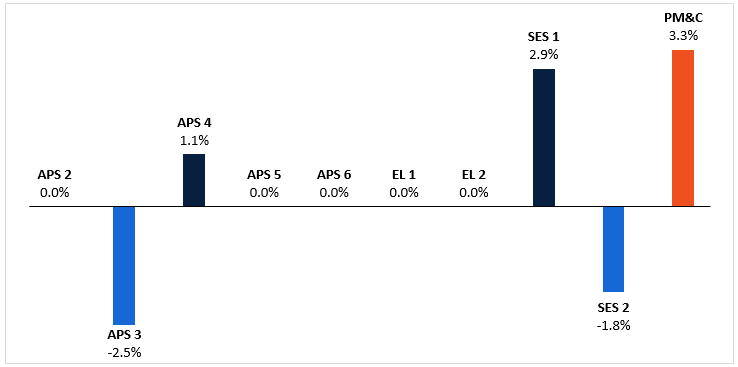PM&C is committed to achieving gender equity which includes ensuring our staff receive equal pay for equal work, regardless of gender. To review whether the department is meeting this commitment, we analyse gendered remuneration annually using data and outcomes from the APS Remuneration Survey, the source of data for the APS Remuneration Report, an annual snapshot of remuneration across the Australian Public Service.
The most recent survey data, shows that PM&C’s gender pay gap was 3.3% at December 2024, a 1.1 percentage point increase from 2023 and 1.1 percentage points below the overall APS rate of 4.4%. This is based off the Australian Public Service’s (APSC’s) primary gender pay gap calculation using an average (mean) base salary metric.
PM&C continues to have no, or negligible, gender pay gap at the majority of classification levels. This indicates that women and men undertaking work of similar value are remunerated relatively equally (Figure 1 and Table 1). For example, at the SES B1 level, the gender pay gap is 2.9%, meaning men are paid slightly more than women.

The gender pay gap at the APS 1 and SESB3 level is excluded from Figure 1 and Table 1, due to the very small number of staff in each cohort (<10). However, these employees contribute to the overall PM&C gender pay gap.
As per the APS Remuneration Survey’s requirements, the Secretary and casual employees have been excluded.
Table 1 – PM&C gender pay gap by substantive classification – December 2024
| Substantive classification | Gender pay gap |
|---|---|
| APS 2 | 0.0% |
| APS 3 | -2.5% |
| APS 4 | 1.1% |
| APS 5 | 0.0% |
| APS 6 | 0.0% |
| EL 1 | 0.0% |
| EL 2 | 0.0% |
| SES B1 | 2.9% |
| SES B2 | -1.8% |
| PM&C | 3.3% |
Gender distribution
PM&C’s gender pay gap is largely driven by the distribution of women and men across the classifications. The distribution of the genders across all classifications is slowly evening out, reducing the organisational gender pay gap over recent years.
In 2024, the decrease in the distribution of women across SES classifications, has influenced the slight upward trend in the gender pay gap. For example, women made up 68% of all PM&C employees, but only 57% of all SES. In 2023, when PM&C’s gender pay gap was 2.2%, women made up 68% of all employees and 62% of all SES.
This under representation of women at higher levels, results in an overall lower average female salary compared with the average male salary. Due to PM&C’s size, individual SES salaries can also influence the gender pay gap.
Given the gender pay gap at the classification levels is relatively low, the smaller proportion of females at the higher classifications is the main driver behind the 3.3% organisational pay gap (see Figure 2 and Table 2). The larger proportion of women at lower classifications makes the average female salary lower. A lower average female salary results in a gender pay gap.

Table 2 – Proportion of women and men at each substantive classification, December 2024
| Substantive classification | Women | Men |
|---|---|---|
| APS 1-3 | 1% | 2% |
| APS 4 | 5% | 3% |
| APS 5 | 11% | 11% |
| APS 6 | 25% | 24% |
| EL 1 | 34% | 33% |
| EL 2 | 16% | 14% |
| SES | 5% | 9% |
What next
PM&C will continue efforts to close the pay gap through a number of levers, including initiatives within the PM&C Inclusion and Diversity Strategy 2023-26. Our policies, strategies and activities are well placed to support the 6 Workplace Gender Equality Agency (WGEA) Gender Equality Indicators and alignment with the APS Gender Equality Strategy 2021-26.
This includes all aspects of our modern and attractive employment framework which supports people of all genders and backgrounds to participate at PM&C and remove barriers to career progression, such as flexible work, parental leave, breastfeeding entitlements, a transparent performance framework and annual pay advancement (including for eligible employees on parental leave).
PM&C’s existing classification salary bands provide parameters to control gender pay inequity. Within the bands, men and women may be paid at different pay-points dependant on levels of skills and experience, usually commencing at the lowest pay point on promotion or engagement then moving up each year.
PM&C is proud of its employee-led Gender Equality Network that champions for equal opportunity and gender equality, supporting all employees to succeed in their professional and personal lives. Like with all PM&C Employee Networks, the Gender Equality Network contributes to a culture where everyone feels valued, safe and included at work.
From 2025 in line with requirements of the Workplace Gender Equality Act 2012, WGEA have released agency-level gender pay gap results. WGEA will include casuals and the Secretary/CEO equivalents in their gender pay gap calculation. Unlike the APSC’s mean base salary metric, WGEA will use a median, meaning their result will vary from the result presented here. In line with the APSC, PM&C will continue to report the gender pay gap excluding casuals and the Secretary.
